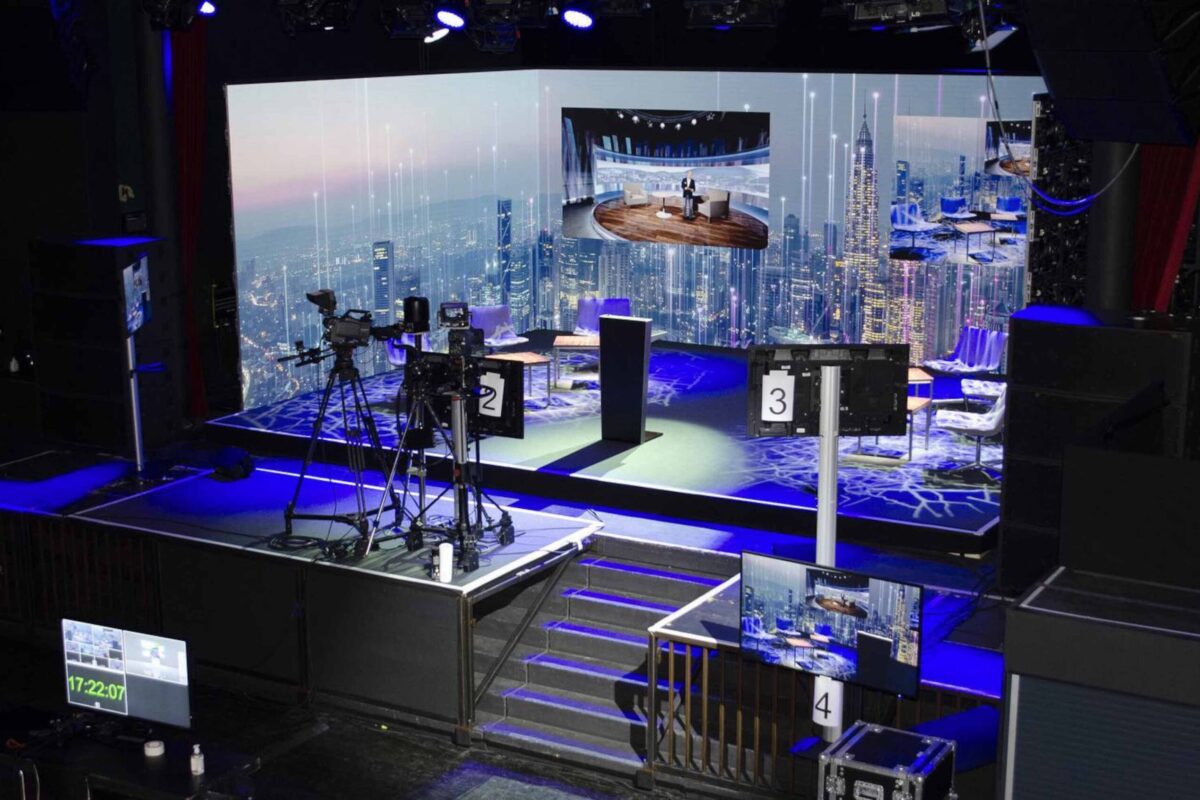Studio Art

Studio Art
Everyone is talking about them: digital events. The circumstances of the Covid19 pandemic are creating new event formats that turn a lot of what has been learned upside down and offer new opportunities. For example, where you previously had large halls with wide stages, workshop rooms and perhaps a separate catering zone, these rooms are now simply no longer needed. Instead, there is a demand for TV studios or locations, where own studios can be integrated. But what types of studios are there? What are their advantages and what are the stumbling blocks? It is precisely these questions that are addressed here under the term “Studio Art”.
Everyone is talking about them: digital events. The circumstances of the Covid19 pandemic are creating new event formats that turn a lot of what has been learned upside down and offer new opportunities. For example, where you previously had large halls with wide stages, workshop rooms and perhaps a separate catering zone, these rooms are now simply no longer needed. Instead, there is a demand for TV studios or locations, where own studios can be integrated. But what types of studios are there? What are their advantages and what are the stumbling blocks? It is precisely these questions that are addressed here under the term “Studio Art”.
There are basically four categories: A) Classic B) Hybrid C) Virtually static/dynamic D) Virtually static/dynamic with AR. Let’s take a closer look at that.
A) Classic
The classic stage design is a completely built set with integrated LED or projection technology to show digital content. In most cases, these are integrated in the set or provided as an add-on. The buildings can consist of different materials and the basic construction is mostly made of wood. Illuminated elements are also integrated in the set in order to stage various moods and light situations.

Example & conclusion: Classic solution
In this example, all 3D elements are built – including LED light edges. Two screens are integrated to display digital content.

Advantages:
– Unlimited use of screens
– Camera movements to create dynamics in the picture
– Can also be used with multiple cameras
Disadvantage:
– Storage
– Wear of materials (service life)
– Maintenance
– Costs for the production of the buildings
B) Hybrid
A hybrid solution is nothing more than a marriage of a real set with virtual elements. If you take exactly the same setup of the classic set and combine it with virtual elements, these usually serve as a background (horizon). They are built using a neutral green box as a so-called hollow as the rearmost level. Everything that is green can be projected on virtually. In this way, the same images are possible as with the classic set, with the difference that the background can be digitally changed with little effort. Various images or video materials can be projected on the background here.

Example & conclusion: hybrid solution
In this example, all 3D elements are built. Very simple construction and with LED illuminated edges. Two screens are also integrated in the set to display content or presentations. In addition, the cove is used as a green box.

Advantages:
– Unlimited use of the screens and the hollow
– Camera movements to create dynamics in the picture
– Can also be used with multiple cameras
– Interchangeable backgrounds to use more staging
Disadvantage:
– Storage
– Wear of materials (service life)
– Maintenance
– Costs for the production of the buildings
– Cost of technology green screen
C) Virtually static / dynamic
The virtual set currently replaces most of the real sets. Technical innovation makes it easier and more realistic to build a virtual set in such a way that you hardly notice any difference to the classic set. The possibilities are practically unlimited. However, since the technical requirements are much more complex than with variants A) and B), it is important to work together with specialist professionals. The image section, for example, must be chosen carefully so that the images gain depth and unfold their effect on the audience.

Example & conclusion: Virtually static / dynamic solution
Only the podium for facilitation is still real. The rest of the studio is computer-generated and is supplied with image and video content.

Advantages:
– Unlimited use of the entire studio environment
– Camera movements to create dynamics in the picture
– Can also be used with multiple cameras
– Interchangeable backgrounds to use more staging.
– No wear and tear, unlimited use
Disadvantage:
– Costs for the production of the digital media (pictures or video)
– Green screen technology costs
– Post-production costs
D) Virtually static / dynamic with AR
The virtual set with AR is a further development of the virtual set. The difference lies in the tracking system with which the cameras are equipped. Tracking allows digital 3D elements to be placed in space to create new levels (AR – Augmented Reality). This is expensive, but unique in terms of visual composition.

Conclusion: Virtually static / dynamic solution with AR
The set itself is identical to the virtual set. However, through the tracking system of the cameras, additional AR levels can be embedded and recorded.

Advantages:
– Unlimited use of the entire studio environment
– Camera movements to create dynamics in the picture
– Can also be used with multiple cameras
– Interchangeable backgrounds to use more staging.
– No wear and tear, unlimited use
– New level through 3D elements AR
Disadvantage:
– Costs for the production of the digital media (pictures or video)
– Green screen technology costs
– Post-production costs
– Cost of tracking system
Would you like to learn more about Studio Art and our options for staging digital events? We are looking forward to your message.
Maximilian Souchay
Managing Partner | Founder

Maximilian studied marketing in Bern and culture management and drama in Liverpool. Before founding Live Lab in 2015, he held a range of management positions within the event industry.




